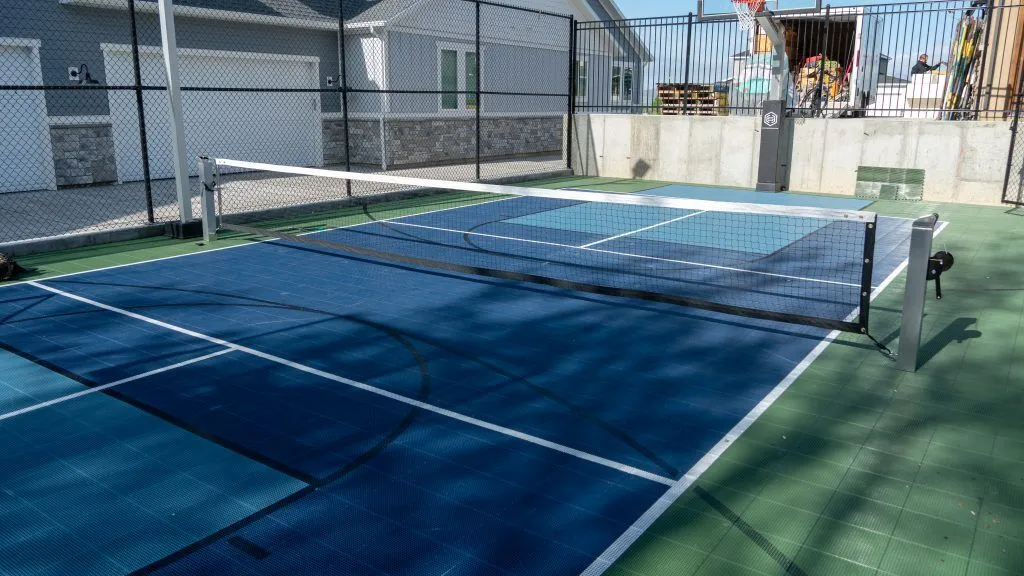Indoor and Outdoor Pickleball Court Construction Providers
Indoor and Outdoor Pickleball Court Construction Providers
Blog Article
Lasting Practices in Pickleball Court Construction You Must Know
As the appeal of pickleball proceeds to climb, so also does the requirement for lasting practices in court building and construction. This strategy not just addresses ecological problems however additionally boosts the longevity and performance of the courts. From picking green products to carrying out effective drainage and energy-saving lights remedies, there are various methods to think about. Yet, the influence of these practices expands far past the court itself. Understanding just how each aspect adds to a more sustainable future invites even more expedition right into the complex equilibrium in between recreational development and ecological stewardship.
Selecting Eco-Friendly Products
Picking green materials is a vital action in the building and construction of lasting pickleball courts. The choice of lasting products not just lessens environmental influence however additionally enhances the durability and efficiency of the court. Secret products include reused rubber for the surface, which uses superb resilience and shock absorption while diverting waste from land fills.
Additionally, making use of in your area sourced materials decreases transportation emissions and sustains regional economic climates. Pickleball court construction. Using native hardwoods for secure fencing and seating can supply a lasting aesthetic while making certain strength versus the aspects.
Incorporating permeable products for court foundations can further add to sustainability by enabling all-natural water drainage and lowering drainage. These choices not only shield local ecological communities however also advertise much healthier play environments.
Effective Water Drainage Solutions
While the selection of green materials is necessary, implementing effective drain remedies is just as vital for keeping lasting pickleball courts. Correct drainage not only safeguards the court surface from water damage however likewise reduces erosion and runoff, promoting ecological integrity.
Reliable water drainage systems can consist of permeable paving, which enables water to infiltrate the ground as opposed to pooling externally. This decreases the possibility of standing water, which can cause mold and other maintenance concerns. Furthermore, integrating tactically placed water drainage channels and swales can direct excess water far from the court area, ensuring a completely dry playing surface area and protecting against soil disintegration.
Using native plant life in the landscape design around the courts can further boost drain by absorbing excess water and lowering runoff. These plants call for less watering and promote biodiversity, lining up with sustainable methods.
Furthermore, it is essential to routinely preserve the water drainage system to ensure its lasting effectiveness. This consists of clearing particles and monitoring for obstructions. By focusing on efficient water drainage solutions, pickleball court erectors can considerably add to the sustainability and durability of the center, inevitably profiting both gamers and the atmosphere.
Energy-Efficient Lighting Options
As the demand for pickleball proceeds to grow, integrating energy-efficient illumination options into court design has come to be significantly important for sustainability. Conventional illumination systems commonly eat extreme power, adding to greater operational expenses and environmental impact. Taking on contemporary, energy-efficient technologies is crucial for both brand-new buildings and renovations.
LED (Light Emitting Diode) lights sticks out as a leading choice because of its longevity and power cost savings (Pickleball court construction). Compared to traditional lighting, LEDs make use of roughly 75% less power and can last as much as 25 times much longer, substantially decreasing maintenance prices. Moreover, the directional nature of LED lighting lessens light pollution, making certain that lighting is focused on the court rather than bordering areas.

Lasting Surface Alternatives
Checking out sustainable surface area options for pickleball courts has actually gained traction among contractors and gamers alike. The focus on eco-friendly materials not just aligns with the expanding ecological recognition yet additionally boosts the efficiency and durability of the courts.
This product offers superb shock absorption, minimizing the risk of injuries for gamers while promoting sustainability. These floor tiles are get redirected here simple to install and replace, read and their adaptability allows for different court configurations.
Natural turf courts are additionally becoming a sustainable option, advertising biodiversity and reducing the warm island impact. They need normal upkeep and water, which might not straighten with all sustainability objectives.

Water Preservation Techniques

Another reliable technique entails the setup of rain harvesting systems. These systems store and accumulate rainwater for use in keeping court surfaces and landscaping. This strategy not only saves safe and clean water however additionally reduces dependence on metropolitan sources.
Additionally, using drought-resistant landscaping around the courts is necessary. Indigenous plants require less water and are better adjusted to neighborhood environment conditions, thus reducing general water intake. Additionally, using effective watering systems, such as drip watering, ensures that water is delivered directly to plant roots, reducing evaporation and waste.
Final Thought
Including lasting techniques in pickleball court construction considerably adds to environmental preservation and resource efficiency. Utilizing eco-friendly materials, implementing efficient drain options, and embracing energy-efficient lights alternatives can greatly reduce ecological influence. Discovering lasting surface area options and using water preservation methods enhance the total sustainability of these leisure centers. By prioritizing these techniques, the building of pickleball courts can align with wider environmental objectives while promoting long life and functionality within communities.
As the appeal of pickleball proceeds to climb, so too does the need for sustainable methods in court building and construction.Picking eco-friendly materials is an essential step in the building of sustainable pickleball courts. By prioritizing energy-efficient lighting options, pickleball court fabricators can contribute to a more lasting future while fulfilling the demands of gamers and stakeholders alike.Incorporating lasting surface alternatives not just boosts the performance of pickleball courts but additionally leads the method for executing effective water preservation methods.Incorporating lasting practices in pickleball court my response building and construction dramatically adds to environmental conservation and resource performance.
Report this page